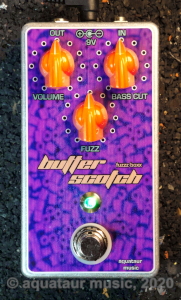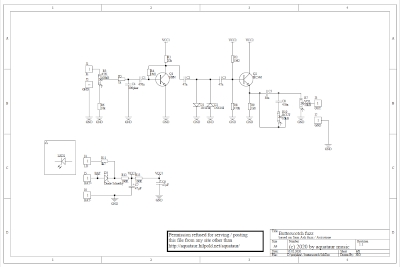|
Butterscotch
Fuzz A buttery sweet and fuzzy sixties overdrive that covers anything from Jimi to Jimmy last update: Feb. 14, 2022 Copyright 2020-2022
by H. Gragger. All Rights Reserved. All
information provided herein is destined for
educational and D.I.Y. purposes only. Commercial
re-sale, distribution or usage of artwork without
explicit written permission of the author is
strictly prohibited. The original units with
their associated trade-names are subject to
the copyright of the individual copyright owner.
The Author is by no means affiliated with any of
those companies. References to trade names are
made for educational purposes only. By reading the
information provided here you agree to the Terms
of
Use.
|
||||
| MAIN PAGE>MUSIC STUFF>BUTTERSCOTCH
Index Circuit Details, General Thoughts On The Architecture There were not much to say about the Ash Fuzz, if you bought a stock specimen right from the store. It stems from a time when valve amps were pretty dark and needed some treble boost, and sounds pretty ghastly to me with all that treble. Tommy Bolin used one, but he compensated its brittle tone with the equalization on his amps to get a great balanced tone. Reportedly, Leslie West used one, too, and he sounds good. As a matter of fact, this peculiarity is probably the cause for its bad reputation. Despite of that, several people offer re-makes of it, probably to exploit the recently re-kindled interest in 60ies units. Somebody else makes the Astrotone, a more or less cosmetic re-vamp in my opinion (the Mojo must be in the transistors they use...) However, the latter company was sane enough to change its frequency range to full-range, and lo and behold, the device sounds great. Too bad its reputation is already stained, because it really, really sounds great with that modification. We will roll up the circuit back-to-front. Tone Control: Back then, they used this very kinky and inefficient bass-cut scheme, which people report as useless, and righteously so. The Astrotone uses an adapted version, but it appears only marginally better. Diystompboxes member DougH suggested an (actually ubiquitous) method (every bass cut on a guitar works like this) - a capacitor that gets gradually bridged by a variable resistor, which lets more bass through. I find a 39 nF output cap for the trebly side useful, while a 470nF together with the pot gives a suitable bass cutoff sweep range. This transforms the Ash Fuzz into something entirely different. It can go even into fuzz face territory, even Tone Bender territory. A "light" version thereof though. Of course the tone pot lets you dial in the original anorectic tone if desired. Output Transistor: The output transistor is just a plain simple voltage follower. Due to the bounding diodes at its base it never receives big signals, it never gets into clipping, nor has it gain on it. I just simply do not believe, that this contributes anything to tone, so I used a modern, low noise transistor. Input Transistor: Not so for the first stage. This is where tone lives. The makers of the Astrotone raised the resistors of the first stage by a hair, which IMHO is just a measure to justify a re-make. This will not do much. Although using a silicon transistor, the one(s) used will likely have been relatively low gain, although not as low as the first transistor in a Fuzz Face. The N.O.S. 2N2962 (allegedly a BC108 sound-a-like) I have galore, works perfectly (gain=150), although it was phased out due to being noisy. A 2N2222 metal can was not bad either, a MPSA06 worked well too. I finally settled for ye old trusted 2N3904 for no other reason than sounding the best of all of them. You could go round and round endlessly finding one that sounds better. All of the above are a lot quieter than the prior specimen. Interestingly, despite the common 1N4148 diode clipper used, this unit sounds nowhere near a contemporary diode clipper device with op-amps. The drive through the front transistor must be so weak that it cannot drive the diodes hard. Some people claim, its sound crosses into overdrive territory - I donīt hear that. In fact, I never had a dedicated (contemporary) overdrive that sounded anywhere nearly as good, neither did any of them react comparable upon volume pot riding. Input Impedance: Despite having a different architecture than a fuzz face, this unit suffers from low input impedance like the fuzz face does. This means, that the guitarīs volume control travel is greatly distorted and thus a small rotation makes a big step in loudness. As may have become obvious by now, this is not something we must live with (unless somebody likes the rather on-off-action of the volume pot). A buffer preceding the effect will restore normal volume control travel. It appears nevertheless that this unit does not react as bad as a fuzz face does, if it is being driven hard. Other little add-ons: Note that I added a small resistor to the ground leg of the input attenuator, which prevents the signal from going to zero. No need to go to zero. I also added the notorious R.F. filter to the input, since the bandwidth of any unit should always be limited to the frequencies of interest. An dedicated anti-pop resistor on the input is superfluous, since there is a 100k resistor there that serves well. Note the way I arranged the supply filtering sequence - like they do it on tube amps: the "quietest" stage on the input receives the most filtered supply rail. Overkill? Maybe, but itīs cheap and does not harm.
Update on transistors: (2022) Nearly on the day two years later: Using the device a certain way (actually the Jimi way - fairly clean with dimed guitar volume, then fuzzy with increasing volume) I realised that noise was building up upon stacking - despite its simple structure. I optimized different parts and managed to further get the noise down. Make sure R2, R8, R4 are metal type since they are high ohm. Q1 used to be a 2N3904 (gain measured with R.G. Keenīs rig = 190), now is a BC549C (BC550 will work the same). Its gain was a little higher, so I inserted a small resistor into the emitter which provides a little degenerative feedback. Its calculated value was 120 Ohms, but 82 Ohms gave equivalent results on the scope. The reduction in noise is noticeable, but small so. Q2 used to be a BC547, now is a BC549C (BC550 will do too). This is a voltage follower and has no gain and thus will not produce much noise by itself, but to be on the safe side... I am convinced that this circuit will sound great with a variety of transistors with out much biasing trouble. Back To Index Sound Samples
The recordings have been done using the following setup and no further processing:
A few quick and nasty takes. No exercise in timing or else, excuse the amateur playing. Crank you speakers. Sounds darker on my Hifi than live.
Note how much different this sounds although I changed nothing on the fuzz! It is also fairly quiet, the unit used for the demos is not even housed! Back To Index Update History
MAIN PAGE>MUSIC STUFF>BUTTERSCOTCH |
||||
MAIN PAGE | MUSIC STUFF | IMPRESSUM  (c) 2020-2022 AQUATAUR Musik & Elektronik |

